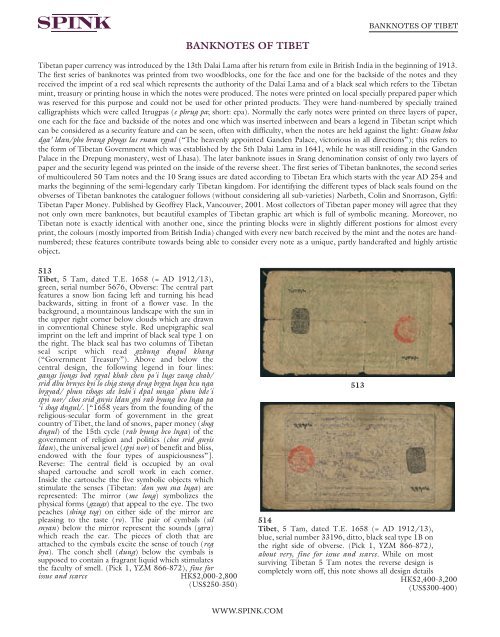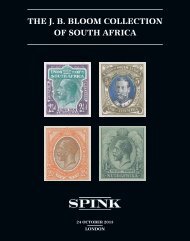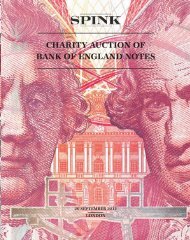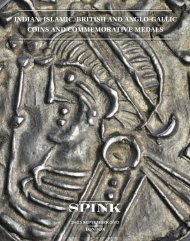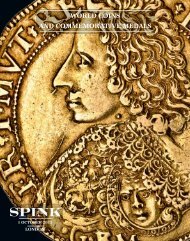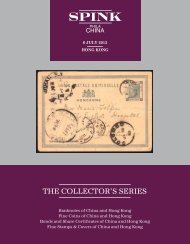Create successful ePaper yourself
Turn your PDF publications into a flip-book with our unique Google optimized e-Paper software.
BANKNOTES OF TIBETBANKNOTES OF TIBETTibetan paper currency was introduced by the 13th Dalai Lama after his return from exile in British India in the beginning of 1913.The first series of banknotes was printed from two woodblocks, one for the face and one for the backside of the notes and theyreceived the imprint of a red seal which represents the authority of the Dalai Lama and of a black seal which refers to the Tibetanmint, treasury or printing house in which the notes were produced. The notes were printed on local specially prepared paper whichwas reserved for this purpose and could not be used for other printed products. They were hand-numbered by specially trainedcalligraphists which were called Itrugpas (e phrug pa; short: epa). Normally the early notes were printed on three layers of paper,one each for the face and backside of the notes and one which was inserted inbetween and bears a legend in Tibetan script whichcan be considered as a security feature and can be seen, often with difficulty, when the notes are held against the light: Gnam bskosdga’ ldan/pho brang phyogs las rnam rgyal (“The heavenly appointed Ganden Palace, victorious in all directions”); this refers tothe form of Tibetan Government which was established by the 5th Dalai Lama in 1641, while he was still residing in the GandenPalace in the Drepung monastery, west of Lhasa). The later banknote issues in Srang denomination consist of only two layers ofpaper and the security legend was printed on the inside of the reverse sheet. The first series of Tibetan banknotes, the second seriesof multicoulered 50 Tam notes and the 10 Srang issues are dated according to Tibetan Era which starts with the year AD 254 andmarks the beginning of the semi-legendary early Tibetan kingdom. For identifying the different types of black seals found on theobverses of Tibetan banknotes the cataloguer follows (without considering all sub-varieties) Narbeth, Colin and Snorrason, Gylfi:Tibetan Paper Money. Published by Geoffrey Flack, Vancouver, 2001. Most collectors of Tibetan paper money will agree that theynot only own mere banknotes, but beautiful examples of Tibetan graphic art which is full of symbolic meaning. Moreover, noTibetan note is exactly identical with another one, since the printing blocks were in slightly different postions for almost everyprint, the colours (mostly imported from British India) changed with every new batch received by the mint and the notes are handnumbered;these features contribute towards being able to consider every note as a unique, partly handcrafted and highly artisticobject.513Tibet, 5 Tam, dated T.E. 1658 (= AD 1912/13),green, serial number 5676, Obverse: The central partfeatures a snow lion facing left and turning his headbackwards, sitting in front of a flower vase. In thebackground, a mountainous landscape with the sun inthe upper right corner below clouds which are drawnin conventional Chinese style. Red unepigraphic sealimprint on the left and imprint of black seal type 1 onthe right. The black seal has two columns of Tibetanseal script which read gzhung dngul khang(“Government Treasury”). Above and below thecentral design, the following legend in four lines:gangs ljongs bod rgyal khab chen po´i lugs zung chab/srid dbu brnyes kyi lo chig stong drug brgya lnga bcu ngabrgyad/ phun tshogs sde bzhi´i dpal mnga´ phan bde´ispyi nor/ chos srid gnyis ldan gyi rab byung bco lnga pa‘i shog dngul/. [“1658 years from the founding of thereligious-secular form of government in the greatcountry of Tibet, the land of snows, paper money (shogdngul) of the 15th cycle (rab byung bco lnga) of thegovernment of religion and politics (chos srid gnyisldan), the universal jewel (spyi nor) of benefit and bliss,endowed with the four types of auspiciousness”].Reverse: The central field is occupied by an ovalshaped cartouche and scroll work in each corner.Inside the cartouche the five symbolic objects whichstimulate the senses (Tibetan: ´don yon sna lnga) arerepresented: The mirror (me long) symbolizes thephysical forms (gzugs) that appeal to the eye. The twopeaches (shing tog) on either side of the mirror arepleasing to the taste (ro). The pair of cymbals (silsnyan) below the mirror represent the sounds (sgra)which reach the ear. The pieces of cloth that areattached to the cymbals excite the sense of touch (regbya). The conch shell (dung) below the cymbals issupposed to contain a fragrant liquid which stimulatesthe faculty of smell. (Pick 1, YZM 866-872), fine forissue and scarceHK$2,000-2,800(US$250-350)513514Tibet, 5 Tam, dated T.E. 1658 (= AD 1912/13),blue, serial number 33196, ditto, black seal type 1B onthe right side of obverse. (Pick 1, YZM 866-872),about very, fine for issue and scarce. While on mostsurviving Tibetan 5 Tam notes the reverse design iscompletely worn off, this note shows all design detailsHK$2,400-3,200(US$300-400)WWW.SPINK.COM


